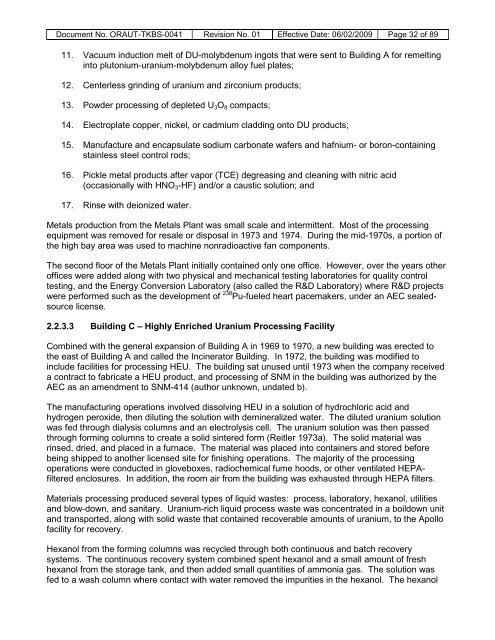ORAU TEAM Dose Reconstruction Project for NIOSH
ORAU TEAM Dose Reconstruction Project for NIOSH
ORAU TEAM Dose Reconstruction Project for NIOSH
You also want an ePaper? Increase the reach of your titles
YUMPU automatically turns print PDFs into web optimized ePapers that Google loves.
Document No. <strong>ORAU</strong>T-TKBS-0041 Revision No. 01 Effective Date: 06/02/2009 Page 32 of 89<br />
11. Vacuum induction melt of DU-molybdenum ingots that were sent to Building A <strong>for</strong> remelting<br />
into plutonium-uranium-molybdenum alloy fuel plates;<br />
12. Centerless grinding of uranium and zirconium products;<br />
13. Powder processing of depleted U3O8 compacts;<br />
14. Electroplate copper, nickel, or cadmium cladding onto DU products;<br />
15. Manufacture and encapsulate sodium carbonate wafers and hafnium- or boron-containing<br />
stainless steel control rods;<br />
16. Pickle metal products after vapor (TCE) degreasing and cleaning with nitric acid<br />
(occasionally with HNO3-HF) and/or a caustic solution; and<br />
17. Rinse with deionized water.<br />
Metals production from the Metals Plant was small scale and intermittent. Most of the processing<br />
equipment was removed <strong>for</strong> resale or disposal in 1973 and 1974. During the mid-1970s, a portion of<br />
the high bay area was used to machine nonradioactive fan components.<br />
The second floor of the Metals Plant initially contained only one office. However, over the years other<br />
offices were added along with two physical and mechanical testing laboratories <strong>for</strong> quality control<br />
testing, and the Energy Conversion Laboratory (also called the R&D Laboratory) where R&D projects<br />
were per<strong>for</strong>med such as the development of 238 Pu-fueled heart pacemakers, under an AEC sealedsource<br />
license.<br />
2.2.3.3 Building C – Highly Enriched Uranium Processing Facility<br />
Combined with the general expansion of Building A in 1969 to 1970, a new building was erected to<br />
the east of Building A and called the Incinerator Building. In 1972, the building was modified to<br />
include facilities <strong>for</strong> processing HEU. The building sat unused until 1973 when the company received<br />
a contract to fabricate a HEU product, and processing of SNM in the building was authorized by the<br />
AEC as an amendment to SNM-414 (author unknown, undated b).<br />
The manufacturing operations involved dissolving HEU in a solution of hydrochloric acid and<br />
hydrogen peroxide, then diluting the solution with demineralized water. The diluted uranium solution<br />
was fed through dialysis columns and an electrolysis cell. The uranium solution was then passed<br />
through <strong>for</strong>ming columns to create a solid sintered <strong>for</strong>m (Reitler 1973a). The solid material was<br />
rinsed, dried, and placed in a furnace. The material was placed into containers and stored be<strong>for</strong>e<br />
being shipped to another licensed site <strong>for</strong> finishing operations. The majority of the processing<br />
operations were conducted in gloveboxes, radiochemical fume hoods, or other ventilated HEPAfiltered<br />
enclosures. In addition, the room air from the building was exhausted through HEPA filters.<br />
Materials processing produced several types of liquid wastes: process, laboratory, hexanol, utilities<br />
and blow-down, and sanitary. Uranium-rich liquid process waste was concentrated in a boildown unit<br />
and transported, along with solid waste that contained recoverable amounts of uranium, to the Apollo<br />
facility <strong>for</strong> recovery.<br />
Hexanol from the <strong>for</strong>ming columns was recycled through both continuous and batch recovery<br />
systems. The continuous recovery system combined spent hexanol and a small amount of fresh<br />
hexanol from the storage tank, and then added small quantities of ammonia gas. The solution was<br />
fed to a wash column where contact with water removed the impurities in the hexanol. The hexanol

















